In the fascinating realm of dog breeds, the Rottweiler stands out as a remarkable combination of loyalty and strength. These incredible canines effortlessly blend raw power with a tender heart and are always ready for adventures with their beloved human companions. Rottweilers are muscular dogs bred to work, but just how much exercise do they need? Join us as we delve into the Rottweiler breed and explore the energy levels and exercise needs of these dogs at every stage of their lives!
The Rottweiler: A Potent Combination of Muscle and Love
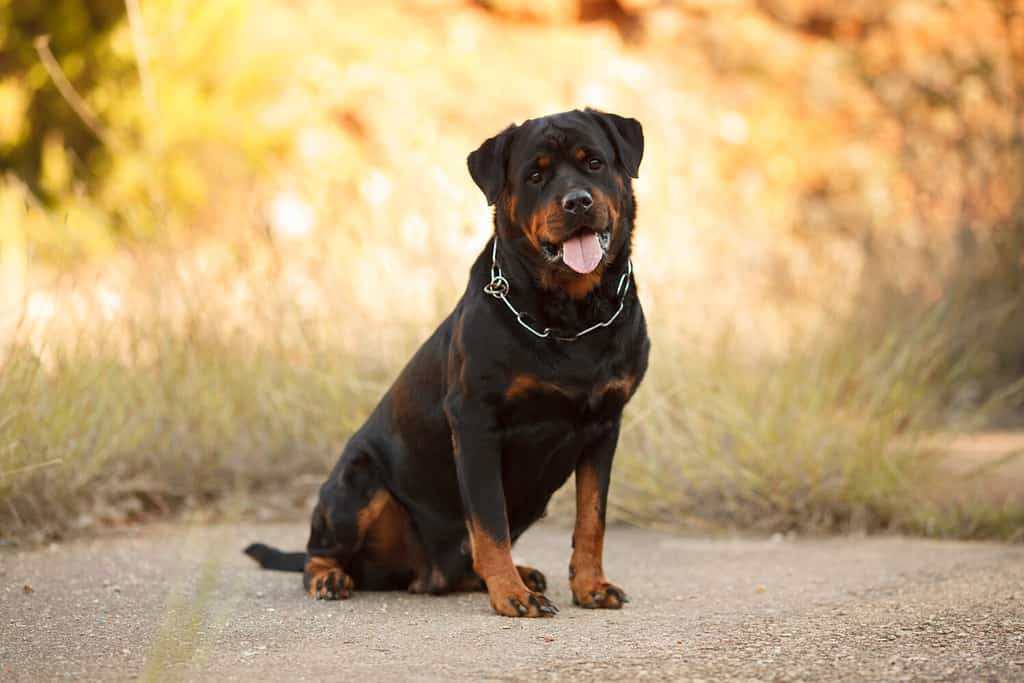
Rottweilers make beloved canine companions.
©Serova_Ekaterina/Shutterstock.com
Rottweilers are incredible dogs that get their name from the German town of Rottweil. Historically, these dogs were used for herding livestock and pulling carts full of meat from Rottweil butchers. Due to their impressive strength and intelligence, today Rottweilers are used not only as herding dogs but also as guard dogs, police dogs, and search and rescue dogs. In addition, Rottweilers also make beloved canine companions.
Rottweilers typically stand 22 to 27 inches tall at the shoulders and weigh between 80 to 135 pounds. They are robust dogs with a lot of muscle. Around strangers, they may act stoic, confident, and protective, but with their own families, they are gentle, playful, and love goofing around.
What if a Rottweiler Doesn’t Get Enough Exercise?
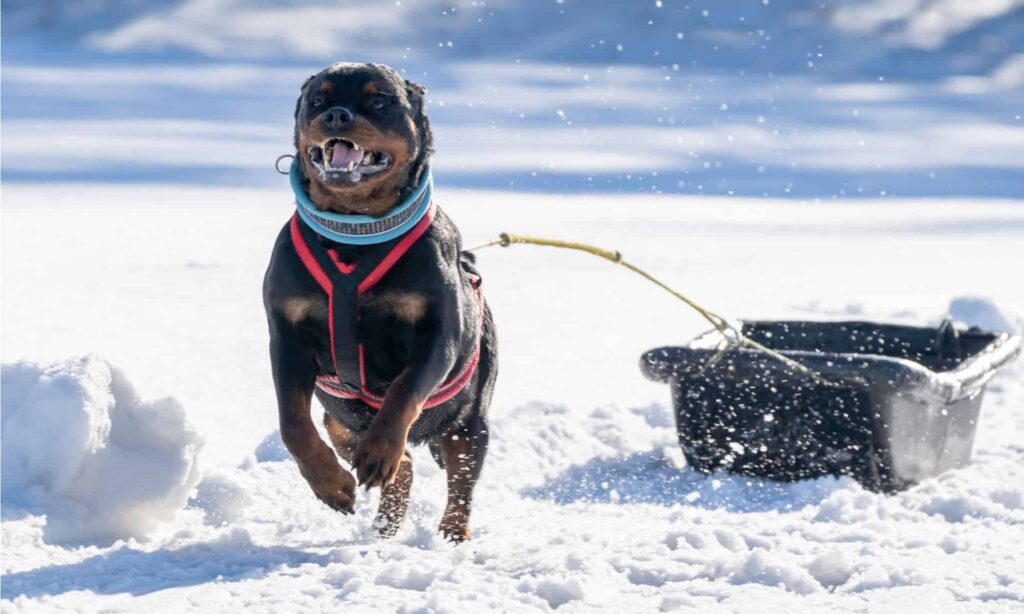
Rottweilers were bred to herd livestock and pull heavy carts.
©Ziga13/Shutterstock.com
Rottweilers are muscular, active dogs, and exercise is absolutely vital to keeping them healthy. These dogs are prone to obesity if they do not get enough exercise. Not only does this affect their quality of life, but it can also cause a myriad of other health issues. An overweight Rottweiler is likely to experience heart failure, difficulty breathing, problems with reproduction, arthritis, skin disease, and overheating.
In addition, exercise is also vital to a Rottweiler’s mental and emotional health. When Rottweilers do not get enough exercise, they can become agitated, anxious, and even aggressive. In addition, they may try to find their own creative ways to burn off excess energy — such as chewing on furniture, digging up holes in your backyard, or barking excessively.
Common problems if a Rottweiler doesn’t get enough exercise:
- Weak joints and stiffness
- Boredom
- Weight gain and obesity
- Excessive barking
- Difficulty focusing
- Destructive behaviors, chewing, digging, etc.
- Heart disease
- Diabetes
- Reproductive issues
- Skin disease
- Arthritis
- Overheating
How Much Energy Does a Rottweiler Have?
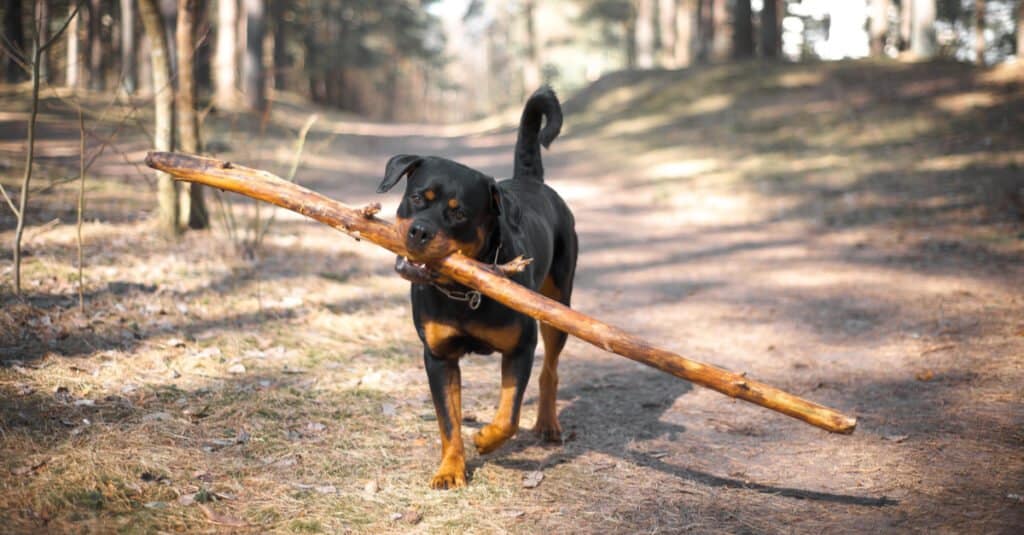
Rottweilers enjoy playing interactive games like fetch and hide-and-seek.
©Mariya Kuzema/Shutterstock.com
The amount of energy that a Rottweiler naturally has depends a lot on how old they are, their health, and their individual personalities. In general, a Rottweiler’s energy levels follow three main stages of life: puppy, adult, and senior.
Rottweiler Puppies: Energy Levels and Exercise Needs

Although Rotweiller puppies love to play and zoom around, they also tire easily and need lots of rest.
©Rita_Kochmarjova/Shutterstock.com
Like most dog breeds, Rottweiler puppies are very energetic and playful. However, they are also small, and their bodies are not fully developed yet. Rottweiler puppies need frequent activity but play sessions should be short as they also get tired quickly. In addition, puppies are much more fragile than adults, so it is important to avoid overexertion or strenuous activities.
| Puppy Age | Amount of Exercise |
|---|---|
| Two months old | Two 10-minute play sessions each day. |
| Three months old | 15 to 20 minutes, twice a day. |
| Four months old | 20 to 25 minutes, twice a day. |
| Five months old | 25 to 45 minutes, twice a day. |
| Six months old | 45 to 60 minutes |
| Eight months and older |
Adult Rottweilers: Energy Levels and Exercise Needs
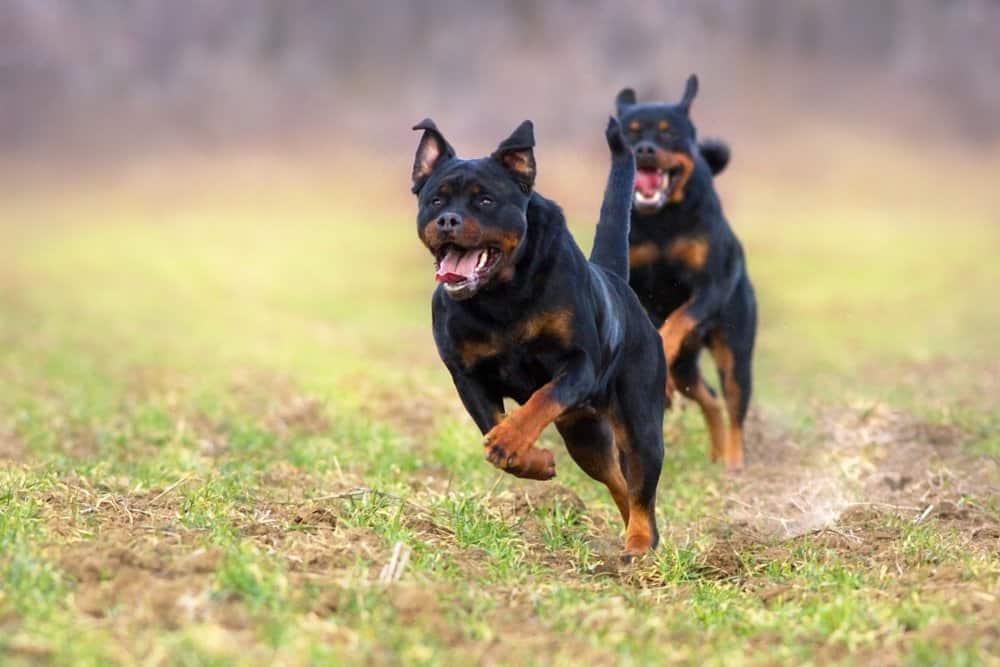
Intelligent and powerful, Rottweilers can learn to do just about anything!
©Callipso/Shutterstock.com
Rottweilers typically reach maturity when they are two to three years old. As adults, they are typically high-energy dogs and need longer periods of exercise than they did as puppies. Adult Rottweilers need at least one to two hours of exercise each day. They are very strong and muscular dogs, but you should always start small and allow your dog to work up gradually to any new activity.
In addition, Rottweilers have their own individual energy levels and exercise needs. Your dog’s personality, temperament, physical condition(s), or medical issues can affect how much exercise they need. It is vital to discuss this with a veterinarian so you can create a personalized plan for your dog’s exercise needs. For example, an obese Rottweiler may not be able to exercise vigorously for one to two hours a day until they lose some weight and increase their stamina. A Rottweiler with hip dysplasia, on the other hand, may require more low-impact activities.
Senior Rottweilers: Energy Levels and Exercise Needs

Rottweilers are “people dogs” and love any activity that allows them to be with their humans.
©Phillip van Zyl/Shutterstock.com
The average lifespan for a Rottweiler is nine to 10 years. So, when your Rottweiler is over seven years old, it’s important to pay close attention to their body and energy levels as they slow down. Senior Rottweilers don’t need as intense or extensive exercise as they did when they were young. However, no matter their age, even older Rotties require regular physical activity and mental stimulation to keep them healthy and strong.
Since older dogs often have less energy and are not as strong as they once were, it’s important to pay attention to your dog so that you can assess and adapt to their exercise needs accordingly. In addition, older dogs are also more likely to develop health problems such as arthritis, and many struggle with weight gain or weight loss, so it’s important to adjust their activities as needed.
In general, senior Rottweilers need 30 to 60 minutes of exercise each day, preferably through low-impact activities like walking and swimming, which put less stress on their aging bodies. To ensure your dog’s overall well-being, be sure to consult with your veterinarian and observe your dog’s behavior to determine their specific needs. Although it may be tempting to let your senior Rottie sleep all day, they still require low-impact activities to maintain their overall health and fitness. However, it is just as important not to overexert them by pushing too hard or engaging in excessively long exercise sessions.
Physical Activities for Rottweilers

Activities that you can do together with your Rottie — no matter how small — are incredibly beneficial.
©bogdanhoda/Shutterstock.com
Most Rottweilers are very active and have a lot of energy, but even the calmer ones still need plenty of exercise. Rottweilers are very athletic and muscular working dogs, and they need to exercise every day. However, what they love the most is doing activities with their human companions.
Common physical activities for Rottweilers:
- Brisk walking
- Running
- Hiking
- Swimming
- Fetch
- Tug-of-war
- Strength and agility training
- Interactive games and play
- Weight pulling (with proper training)
- Dog sports
- Herding
- Flirt pole
- Chasing pet-safe bubbles
Mental Activities for Rottweilers
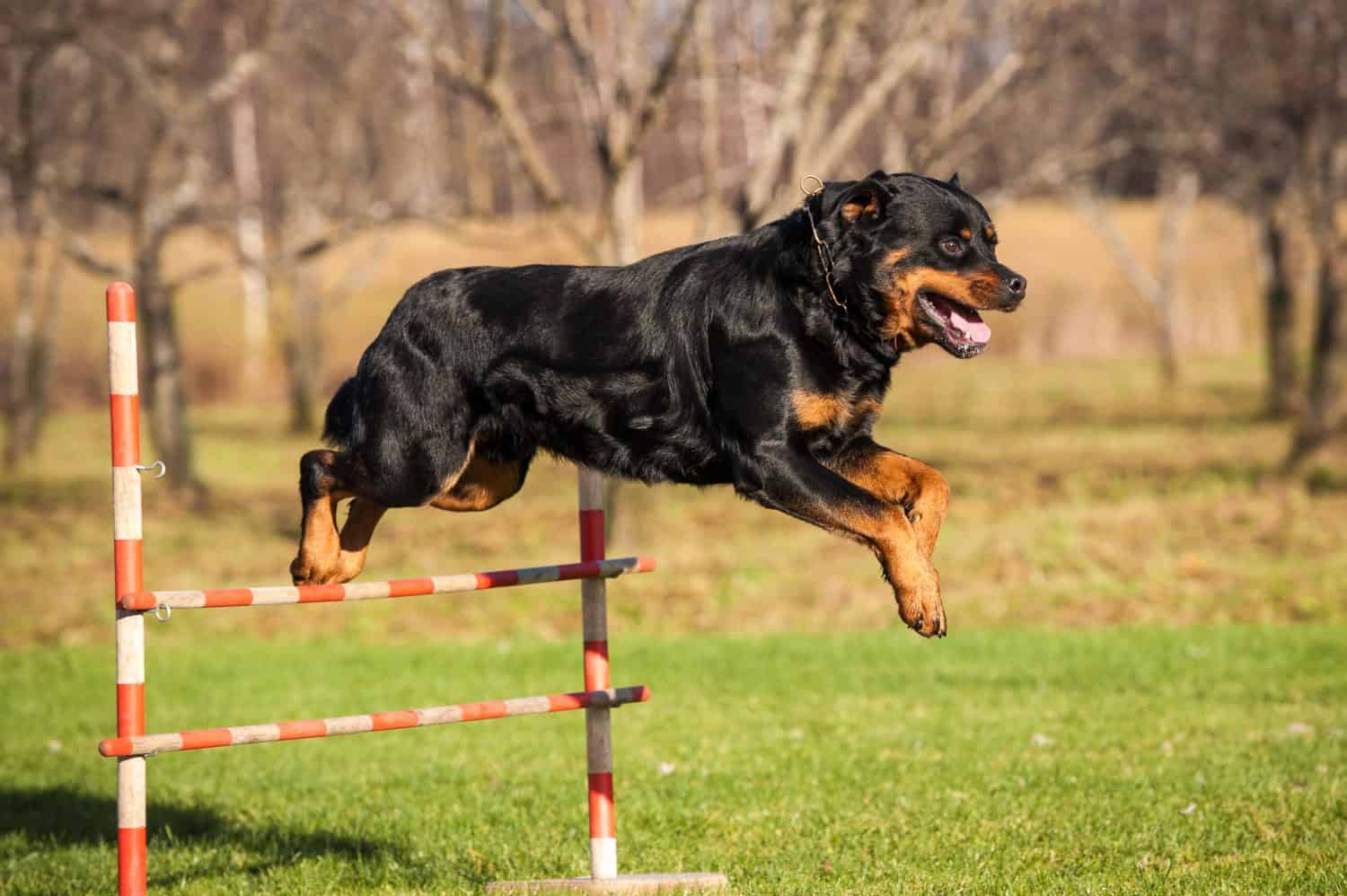
Rottweilers are happy when they have a job or a purpose, such as tracking, herding, and agility training.
©Rita_Kochmarjova/Shutterstock.com
Keeping your Rottweiler’s mind healthy and engaged is just as important as exercising their body. Rottweilers are extremely intelligent, and they get bored easily, so it’s important to provide them with lots of variety.
Here are some examples of common mentally stimulating activities for Rottweilers:
- Obedience and socialization training
- Puzzle games and toys
- Agility courses
- Scent games and tracking
- Interactive games like hide-and-seek
- Obstacle courses
- Clicker training
- Target training
Tips for a Happy and Healthy Rottweiler

Consistent training and socialization are key to raising a well-mannered and healthy Rottweiler.
©TrapezaStudio/Shutterstock.com
- Start with shorter exercise sessions to gradually build up your dog’s endurance as they grow older. In addition, gradually introduce new activities to prevent injuries.
- Pay attention to your Rottweiler’s individual needs and adjust activities and exercise accordingly.
- Strenuous activity in hot weather can lead to overheating, so opt for indoor exercises or cooler times during the day. Likewise, when it’s extra cold outside you may need to enjoy some indoor activities with your dog.
- Always provide fresh water and regular rest breaks.
The photo featured at the top of this post is © cynoclub/Shutterstock.com
Ready to discover the top 10 cutest dog breeds in the entire world?
How about the fastest dogs, the largest dogs and those that are -- quite frankly -- just the kindest dogs on the planet? Each day, AZ Animals sends out lists just like this to our thousands of email subscribers. And the best part? It's FREE. Join today by entering your email below.
Thank you for reading! Have some feedback for us? Contact the AZ Animals editorial team.







